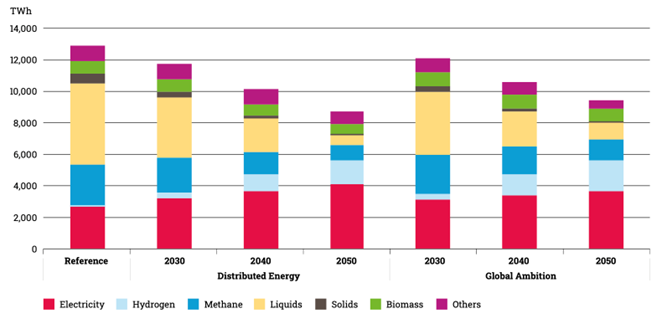Blog / Knowlegde Bites
EU-level electricity sector regulation: an enabler of the energy transition
What role does the electricity sector play in reaching EU climate pledges?
The EU has committed to reach net-zero emissions by 2050. Today, 77% of the EU’s current domestic Greenhouse Gas Emissions are directly imputable to energy consumption, which is still around 60% fossil fuel-based. A huge and fast-paced transition from fossil-based to low-carbon resources is therefore required.
Electricity is a pivotal energy carrier for the energy transition, for three main reasons. First, this carrier is technically and economically realistic to decarbonize, through e.g. wind, solar photovoltaic, and nuclear generation. Second, many final energy uses can be switched to electricity, including in the industry, transport (e.g. battery electric vehicles), and residential sectors (e.g. electrical heat pumps). Additionally, for non-electrifiable uses that require gaseous or liquid energy carriers, electricity can be used to produce decarbonized hydrogen or synthetic liquid fuels.
As a result, the relative share of electricity and its derivatives (e.g. hydrogen) in the final EU energy demand is expected to increase significantly. Electricity production is foreseen to roughly double between today and 2050.
Evolution of the final energy demand per carrier (EU27).
Source: ENTSOS, TYNDP 2022 scenario report. Note: Distributed Energy and Global Ambition are two energy transition scenarios developed by the ENTSOS.

What is the role of EU-level regulation for the electricity system?
In the EU, national electricity markets were progressively integrated into more regional markets. This integration is translated into a set of EU regulations and directives, as well as network codes and guidelines. This means that EU-level decisions, and the European Parliament’s position, will play a key role in the sector’s evolutions.
The benefits of electricity interconnectivity and market integration are wide. From an economic perspective, cross-border trade is estimated to save approximately €34 billion a year. From a reliability perspective, increasing the perimeter and interconnectivity of the electricity system reduces the risks of outages and the need for ‘backup’ resources. Finally, from an energy transition perspective, cross-border trade enables making the most of variable renewable production, by exploiting geographic and natural complementarities.
What are today’s challenges for EU electricity regulation?
The gas price crisis induced by the invasion of Ukraine has been accompanied by an electricity price crisis. Significant increases in electricity prices and bills in 2022-2023 triggered calls to reform the electricity market design in order to reduce interlinkage with gas prices. In the end, the EU institutions agreed to enhance, rather than completely reform, the EU electricity markets. The crisis has shed light on important weaknesses in the current EU electricity market design, which the reform of 2024 aims to address. The crisis also led to an increase of the EU renewable deployment objectives.
Aside from the crisis, the transition of the electricity sector raises numerous regulatory challenges. On the generation side, fast-paced investments in low-carbon resources must be enabled to decarbonize and increase production. On the demand side, affordability and price stability must be sought to reduce energy poverty and enable the electrification of uses. Moreover, electricity grids must be reinforced, extended, and modernised to enable the transition. Other challenges include empowering consumers, handling interlinkages with the hydrogen system, and offshore regulation. These make planning, cooperation, and when possible, coordinated regulation at the EU level even more crucial.
At the Florence School of Regulation, we have contributed to the market reform debate by commenting on the reform proposal, organizing debates, and more recently, proposing ideas for the new Commission. Moreover, we are researching how to future-proof the EU electricity markets and regulations. A key issue is long-term instruments, which will play an increasingly important role in the future electricity system.
Which role should EU vs national level regulation play?
The long-term components of electricity regulation will play an increasingly important role, and a number of these components are currently conceived at the national level. National-level regulatory flexibility is required for tailoring solutions to specific needs and identifying and sharing best practices in the end. However, national-level regulation also comes with a risk of fragmenting the EU-integrated electricity markets, i.e. creating significant differences between member states, which can result in inefficiencies. A balance must therefore be found between tailored national solutions and harmonized or integrated EU regulations.
In most member states, renewable deployment is driven by public support schemes delivering long-term contracts. Member states have been relatively free in the design of such schemes. The crisis and past experiences have allowed identifying the best practice mechanism, the so-called ‘two-way contracts for difference'. The reform of 2024 makes the use of this mechanism for all new renewable support schemes mandatory. Similarly, the reform foresees a streamlining of another type of long-term instrument used by some member states, the so-called “capacity mechanisms”. We can therefore observe a gradual harmonisation.
Conclusion
The challenges to be addressed at the EU level are twofold. First, EU regulation will have to adapt to, and enable, the energy transition, on many levels. Second, this adaptation must continuously strike the right balance between national tailoring versus EU-level harmonisation. At the Florence School of Regulation, we will continue to contribute to the regulatory debate and conduct research on how to future-proof the EU electricity markets and regulation.
Emma Menegatti is part of the Florence School of Regulation research team in electricity regulation and policy. She is currently a PhD candidate, investigating the future of capacity remuneration mechanisms in the EU electricity markets.